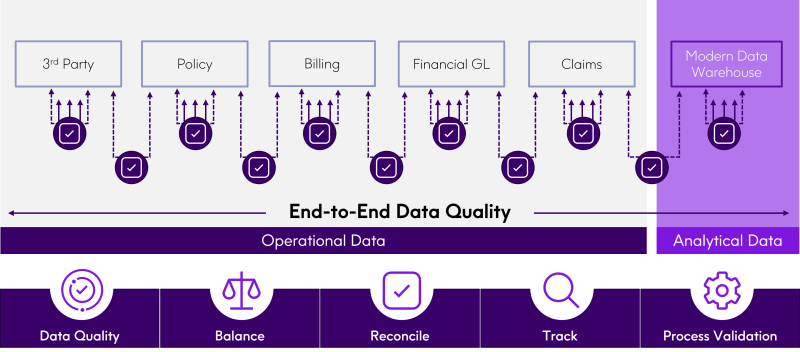Data360 DQ+
Boost the quality of your data in-motion and at-rest with enhanced monitoring, visualization, remediation, and reconciliation.
ReadData Quality
Increase accuracy, improve operational efficiency, and mitigate risk with automated data reconciliation.
Data reconciliation is the process of comparing two or more datasets to reveal discrepancies, so you can be sure your data is accurate and complete across sources. With the right automated data reconciliation solutions across your business, you begin to experience big benefits – faster.
Customer story
See how a top multi-line insurance company improved operational efficiencies and reduced regulatory risk with end-to-end financial reconciliation.
What areas of your organization currently reconcile data using spreadsheets? It’s an old-school way of operating, and it takes more time than it needs to. Automating enterprise reconciliation capabilities save your team valuable time, enabling them to:
Having a consistent, repeatable technique to perform data reconciliation activities across your organization helps to:
Ensuring the accuracy of your information using data reconciliation capabilities reduces potential risks to your organization. Automated data reconciliation capabilities help you:
The ecosystem of large organizations is complex. Data is constantly moving between a variety of systems to enable operational and analytic processes. Data needs to be validated when it enters the organization and ongoing data quality checks are critical for both data in motion and at rest (stored in a specific location).
You need to ensure that data isn’t lost or transformed incorrectly as it moves throughout your organization. Some organizations refer to this as adding controls to the processes. This includes performing reconciliation on streaming data using various technologies, like Kafka.
Think of the impact of a $300,000 payment that’s incorrectly transformed to become a $3,000,000 payment. Small changes like this can have catastrophic impacts. Errors like these need to be caught before they affect downstream processes.
Precisely customer success story
Learn about the $10M mistake that almost went undetected by a large insurer – and how automated data quality rules saved the day.
Imagine getting your organization’s internal data reconciled, then having a partner send data that creates errors or duplicate records.
Frustrating, right? Unfortunately, this happens at many organizations. The good news is that it’s avoidable with an automated enterprise reconciliation solution that compares incoming data with data already in your systems. This prevents the introduction of new data problems into your current environment.
Once you achieve high-quality data internally and you have a consistent process in place to validate incoming data, you can implement SLAs on data sent to you to ensure its quality meets your standards.
Precisely customer success story
See how a multi-billion dollar media company improved its internal processes by implementing reconciliations with incoming data from its vendors.
Before data reconciliation, you need to ensure that standard data quality checks have been performed on the data being used. Examples of these data quality validations include:
This is just a sample of the data quality checks that may need to be applied to your data prior to data reconciliation. If you don’t perform these basic data validations first, then the reconciliation results may be unreliable.
Learn more about our data quality solutions
How many of your data reconciliation processes are performed using a spreadsheet and then sending an email with exceptions? As you’ve probably noticed, this method is inconsistent, error-prone, and difficult for auditors to monitor.
That’s what makes an enterprise data reconciliation solution critical. It provides an array of benefits including:
Protect your organization with a unified data reconciliation process that’s automated, auditable, and reduces risk of compliance violations.
You may be wondering how data reconciliation helps solve your specific challenges. Here are a few examples by industry:
Financial services reconciliation
Insurance reconciliation
Telecommunications and utilities reconciliation

Whatever your industry may be, all have something in common: data reconciliation helps solve challenges across the organization.
What are the biggest issues you need to tackle today? How can data reconciliation help? Now that you’ve found some inspiration through the use cases and success stories highlighted here, we want to hear from you.
Reach out to us for more information and to start experiencing the data reconciliation benefits for yourself today.
Check out our data observability solutions to learn more.